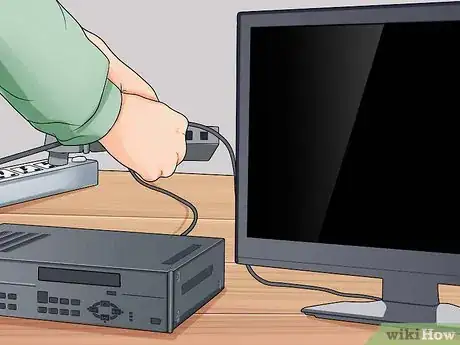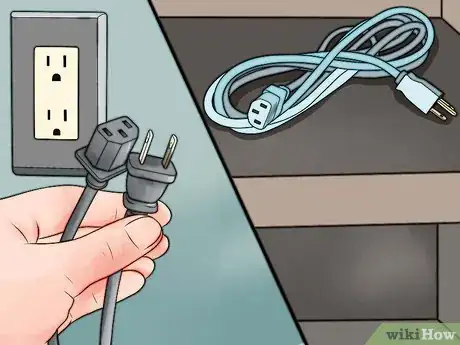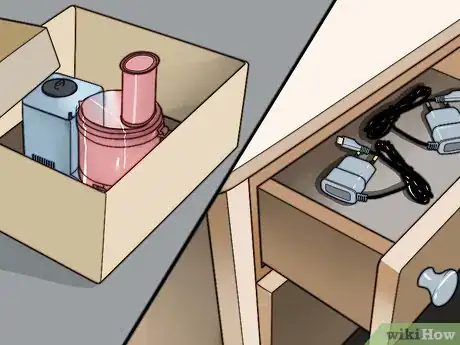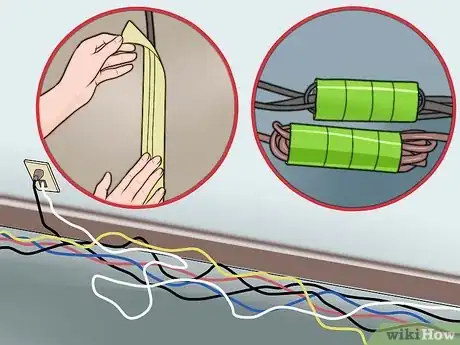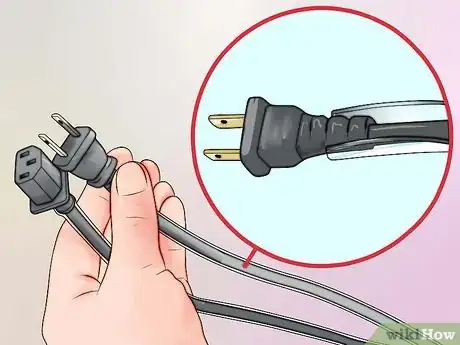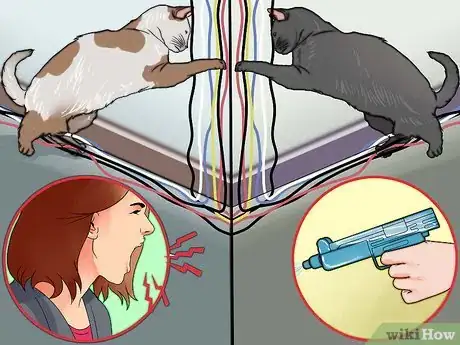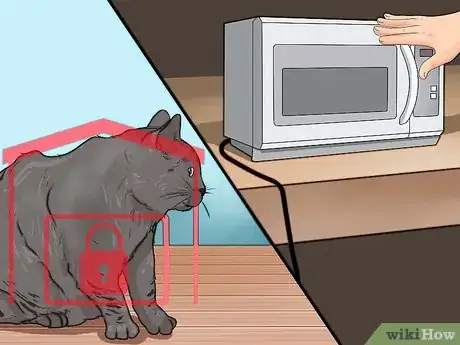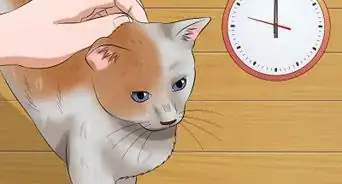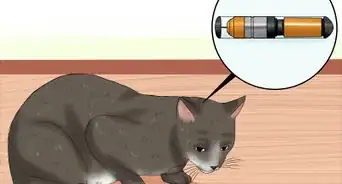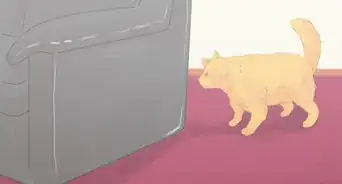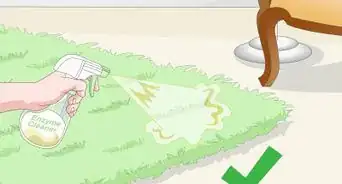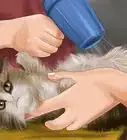This article was co-authored by Pippa Elliott, MRCVS. Dr. Elliott, BVMS, MRCVS is a veterinarian with over 30 years of experience in veterinary surgery and companion animal practice. She graduated from the University of Glasgow in 1987 with a degree in veterinary medicine and surgery. She has worked at the same animal clinic in her hometown for over 20 years.
There are 10 references cited in this article, which can be found at the bottom of the page.
wikiHow marks an article as reader-approved once it receives enough positive feedback. In this case, several readers have written to tell us that this article was helpful to them, earning it our reader-approved status.
This article has been viewed 980,927 times.
Cats are less likely to chew cables compared to dogs, but every precaution should be taken to make sure cats are safe if they do chew. Not only does chewing and biting damage the cords, but it can result in terrible harm to your cat, such as electric shock or choking. Keep in mind, however, that this is typical for teething younger cats, and even the most devoted cord-chewers tend to grow out of it.
Steps
Finding and Minimizing Cords
-
1Work out where the electrical hazards in your home are. Every electrical item at cat level is a potential hazard, as are items the cat can reach and jump to. Be especially careful of cords from appliances, cords from computing and printing equipment, cords used temporarily for such things as Christmas tree lights, cords in places you can't reach but your cat can (for example, behind heavy items such as fridges, freezers, heaters, and televisions), and all electrical outlets.[1]
-
2Keep the gaps between any cord protection and the termination points as small as possible. The most vulnerable parts of the cord are where the wire joins the plug or appliance. These sections are not easily protected by cord protection kits. Check them regularly.[2]
- If the gap between an appliance like a fridge or is wide enough for a cat to slip down or into, then you need to take precautions to guard the relevant electrical cord and outlet.
Advertisement -
3Unplug unnecessary appliances and put them away in a safe, cat-free space until needed. When needed, do not leave them unattended, or confine their use to safe, cat-free spaces. There is no point leaving unused appliances out gathering and taking up space when they could be neatly tucked away, unchewed and dust-free.[3]
Hiding Cords
-
1Rearrange your furniture to provide protection for hanging cords or cords that tend to move. Block the base and/or back of tables or book cases that have a gap between the floor and the bottom of the unit or the wall and the back of the unit. Remember that cats can slink into openings smaller than your fist, depending on the cat's size. Your cat can also move objects that aren't firmly fastened or are heavy. Hide as much of the cord from your cat as possible. Tidy up unnecessary corded appliances and put them away in a safe, cat-free location.[4]
- Consider using wireless technology wherever possible, confining the cords to the transmitters to protected or cat-free areas.
-
2Put small appliances or chargers in boxes or drawers. If you can create a charging station in a drawer, the cat will be unable to get at many of the smallest and most attractive cords. Putting items with cords in boxes (with a hole cut out the back) can also disguise their true function and make it less likely that a cat will pounce.[5]
-
3Tape all dangling cords down so that they don't dangle. It's the dangling that often attracts the cat; once taped firmly to a table leg or wall, the cord blends in and ceases to provide the same attraction. You can also purchase velcro attachments or special cord clips to keep cords attached flatly to another item.[6]
-
4Buy cord management covers. These are available at a hardware store in a variety of formats and colors. Some attach to the wall or furniture, while other just bundle the cords together. Regardless of the kind you choose, they are a plastic cover for your cords that a cat cannot bite through.[7]
Making Cords Unappealing
-
1Make the cord distasteful. Spray or wipe down cords with something distasteful to the cat. There are commercial product solutions and homemade solutions. If making your own, consider using such things as hot sauce; lavender oil; a homemade citrus or vinegar paste; garlic, cayenne pepper, Vicks, dish soap, lime juice,or chili oil or paste. Some people use a light coating of sports ointments (the really strong menthol sort) or deodorant . Be sure to let the applied substance dry completely before re-plugging the cord into the wall and you'll need to reapply homemade fixes periodically. Avoid using anything salty because cats love licking salt.[8]
-
2Cover cords with something solid that deters chewing. Commercial products include "Chewsafe™" and "CritterCord™", which are clear, flexible protective cord covers infused with a citrus-scent to keep the cat away from the cord. These are easy to add and don't require topical re-applications.[9]
-
3Disguise cords with tape. Both foil and double-sided tape can work. These can be purchased from the hardware store and are easy to wrap around the cords. With the foil tape, cats dislike the alkaline taste in their mouth and will refrain from chewing anything coated in the tape. With double-sided tape, cats hate anything sticky and won't touch it. The problem with this method is that it is sticky, and therefore tricky, and will also collect a lot of fluff for you.[10]
Distracting your Cat
-
1Try noise or rapid action to deter your cat. There are several things you can do if you catch your cat in the act. Yelling a loud "NO" or clapping your hands every time the cat goes near the cord is one possibility. Another is to keep a water-gun handy for squirting your cat when it gets too close to places you don't want it going. Obviously, be careful not to hit electrical or electronic equipment with the water.[11]
-
2Use a motion detector with noise. If you can find a motion-detector toy that makes a noise as soon as it spots motion (for example, a frog that croaks), consider placing it strategically to go off every time the cat gets near certain vulnerable cords, such as under the computer desk. It will need to be loud and sudden enough to scare off your cat, and there is a chance that he'll just get used to it and ignore it.
-
3Find distractions. Cord chewing can be a sign of boredom, a sign of practicing prey hunting, or just a need to play. Try new items at home to keep your cat interested -- a carpet square, cardboard boxes to shred, or even a rubbery dog chew toy.[12]
-
4Try cat grass. Purchase or grow some cat grass grown from oats or wheat. Many cats feel the need to chew on grass, and without grass, the next closest thing is string and wires. Cat grass is available in pet stores and on the internet, and you can buy seeds of oats and wheat and grow them yourself in a pot with a little soil. You can even dig up a little sod from a yard that is not treated with pesticides or herbicides. Look to make certain the sod only contains grass leaves, no weeds. Place the clump of sod in the pot on the floor and let the cat chew on it. Release the sod to its original place when the cat is done chewing on it. Repeat frequently, as needed.[13]
-
5Give your cat plenty of fun cat toys. When cats chew cords, they're often looking to create small toys for themselves. Short wires skitter across linoleum and hardwood floors quite marvelously when batted by a furry paw. You might try distracting your cat with a different sort of toy. Just be sure to avoid any toys that encourage wire-chewing behavior (such as toys which are wire-like using string, yarn, etc.).[14]
-
6Keep the cat away when moving items with cords. There are some activities where cord movement is inevitable and it is probably best to keep your cat locked out of the room or space where you're using such appliances rather than risk chewing and the potential for electrical shock to both you and your cat, as well as the potential for a heavy item falling on your cat if the cord is pulled down too much.
Expert Q&A
Did you know you can get expert answers for this article?
Unlock expert answers by supporting wikiHow
-
QuestionHow do I convince my parents that wires can be covered and it's safe to get a cat?
 Pippa Elliott, MRCVSDr. Elliott, BVMS, MRCVS is a veterinarian with over 30 years of experience in veterinary surgery and companion animal practice. She graduated from the University of Glasgow in 1987 with a degree in veterinary medicine and surgery. She has worked at the same animal clinic in her hometown for over 20 years.
Pippa Elliott, MRCVSDr. Elliott, BVMS, MRCVS is a veterinarian with over 30 years of experience in veterinary surgery and companion animal practice. She graduated from the University of Glasgow in 1987 with a degree in veterinary medicine and surgery. She has worked at the same animal clinic in her hometown for over 20 years.
Veterinarian Show willingness by tidying the wires in your bedroom as an example of how it's possible to make a safe environment for a cat. (Be careful handling plugs and cables; if necessary, unplug electrical equipment from the mains or turn the power to the socket off). Show your parents what a good job you did, and offer to cat-proof the rest of the house. If they are unconvinced, ask them if this is the only reason they don't want to get a cat and to be honest about why.
Show willingness by tidying the wires in your bedroom as an example of how it's possible to make a safe environment for a cat. (Be careful handling plugs and cables; if necessary, unplug electrical equipment from the mains or turn the power to the socket off). Show your parents what a good job you did, and offer to cat-proof the rest of the house. If they are unconvinced, ask them if this is the only reason they don't want to get a cat and to be honest about why. -
QuestionHow do I keep my cat from chewing on cords?
 Pippa Elliott, MRCVSDr. Elliott, BVMS, MRCVS is a veterinarian with over 30 years of experience in veterinary surgery and companion animal practice. She graduated from the University of Glasgow in 1987 with a degree in veterinary medicine and surgery. She has worked at the same animal clinic in her hometown for over 20 years.
Pippa Elliott, MRCVSDr. Elliott, BVMS, MRCVS is a veterinarian with over 30 years of experience in veterinary surgery and companion animal practice. She graduated from the University of Glasgow in 1987 with a degree in veterinary medicine and surgery. She has worked at the same animal clinic in her hometown for over 20 years.
Veterinarian To a cat, cables and cords can seem like wiggly snakes and are inviting to play with or chew. The best option is to conceal the cables in trunking or behind furniture. If the cat chews on the power cable to a laptop (which you move around), try and conceal the cable under a blanket or behind your legs.
To a cat, cables and cords can seem like wiggly snakes and are inviting to play with or chew. The best option is to conceal the cables in trunking or behind furniture. If the cat chews on the power cable to a laptop (which you move around), try and conceal the cable under a blanket or behind your legs. -
QuestionI'm on oxygen, which is piped to me via long tubes that run all over the home. My cats chews these when I'm not looking. What can I do?
 Pippa Elliott, MRCVSDr. Elliott, BVMS, MRCVS is a veterinarian with over 30 years of experience in veterinary surgery and companion animal practice. She graduated from the University of Glasgow in 1987 with a degree in veterinary medicine and surgery. She has worked at the same animal clinic in her hometown for over 20 years.
Pippa Elliott, MRCVSDr. Elliott, BVMS, MRCVS is a veterinarian with over 30 years of experience in veterinary surgery and companion animal practice. She graduated from the University of Glasgow in 1987 with a degree in veterinary medicine and surgery. She has worked at the same animal clinic in her hometown for over 20 years.
Veterinarian
Warnings
- If your cat swallows any pieces of cord, go straight to your vet; these pieces can become lodged in the cat's intestine and cause many problems.⧼thumbs_response⧽
- In addition to cords and wires, keep strings, threads, and elastics away from your cat. Not only do they encourage the same chewing behavior, but they can be fatal to your furry friend if swallowed. They can get tangled in their intestines and cause serious medical problems. If you suspect your cat may have swallowed a cord, you may want to have a vet look at it, just to be safe.⧼thumbs_response⧽
- Check the state of your cords regularly. Cats are small, they're clever, and they're persistent. They may cause damage to the cord even without actually severing it. A damaged cord can cause fire. Replace or repair any damaged cords immediately.⧼thumbs_response⧽
- Don't make a habit of yelling at your cat or kitten. This can lead to your cat becoming aggressive or antisocial.⧼thumbs_response⧽
References
- ↑ http://www.humanesociety.org/animals/cats/tips/cat_proofing_your_house.html
- ↑ http://www.humanesociety.org/animals/cats/cat_problem_solver/home.html
- ↑ http://www.humanesociety.org/animals/cats/tips/cat_proofing_your_house.html
- ↑ http://www.humanesociety.org/animals/cats/cat_problem_solver/home.html
- ↑ http://www.boredpanda.com/interior-design-life-hacks-hiding-eyesores/
- ↑ http://www.tenthlifecats.org/all-about-cats/cat-behavior/cord-chewing
- ↑ http://www.homedepot.com/b/Electrical-Home-Electronics-Cable-Management-Cord-Covers/N-5yc1vZc65e
- ↑ http://www.petful.com/behaviors/how-stop-kitten-biting-wires/
- ↑ http://www.countryliving.com/life/kids-pets/a3017/cat-chewing-wires-1009/
- ↑ http://www.countryliving.com/life/kids-pets/a3017/cat-chewing-wires-1009/
- ↑ http://www.knowyourcat.info/info/notraining.htm
- ↑ http://www.naturalcatcareblog.com/2012/07/6-ways-to-stop-risky-cat-chewing-without-losing-your-mind/
- ↑ http://www.drsfostersmith.com/pic/article.cfm?aid=373
- ↑ http://www.naturalcatcareblog.com/2012/07/6-ways-to-stop-risky-cat-chewing-without-losing-your-mind/
About This Article
To keep cats from chewing on electrical cords and chargers, try to keep them behind desks and appliances, and make it difficult for the cat to get back there. If that isn’t possible, try taping the wires to the wall so they don’t dangle and draw attention. You can also spray the wires with dish soap or hot sauce so the cat won’t like them. Or, cover the cords with flexible cord covers infused with a citrus scent to deter the cat. For advice from our Veterinary reviewer on distracting your cat and making it less bored, keep reading!
